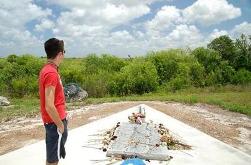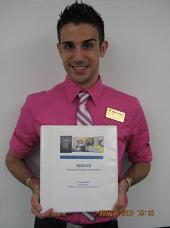 Last week, I took a trip to south Florida to see my grandma as a late Mother’s Day present. While I was down there with my friend, we went to the Valujet Airlines Flight 592 memorial site in the Everglades. Flight 592 experienced an in-flight fire back in 1996 and impacted the ground while attempting to return to Miami killing all 110 aboard the DC-9. Being involved in Aviation Safety, I knew how important it was to visit the site so that number one, the people are not forgotten and number two, that we remember our past and do not repeat our mistakes. The site was very touching and meeting a family of one of the flight attendants was also a good reminder of why I do what I do every day in the classroom.
Last week, I took a trip to south Florida to see my grandma as a late Mother’s Day present. While I was down there with my friend, we went to the Valujet Airlines Flight 592 memorial site in the Everglades. Flight 592 experienced an in-flight fire back in 1996 and impacted the ground while attempting to return to Miami killing all 110 aboard the DC-9. Being involved in Aviation Safety, I knew how important it was to visit the site so that number one, the people are not forgotten and number two, that we remember our past and do not repeat our mistakes. The site was very touching and meeting a family of one of the flight attendants was also a good reminder of why I do what I do every day in the classroom.
In April I got hired as a monorail pilot at the Walt Disney World Resort and I began my first day a few weeks after getting hired. My job is so cool! I get to interact with people from all over the world, load then drive 12 different color trains and promote a safe environment for my fellow cast members and guests.
 My first day on the job was fun. I got to actually take part in interacting with the guests and the trains. I learned my general duties as a monorail pilot and the safety procedures that are in place to maintain a safe yet efficient environment. My training comes in two parts; platform and drive. I will learn to actually drive the trains in about 30 days from my hire date but throughout the course of my platform training I will learn little by little the skills to successfully pilot a train.
My first day on the job was fun. I got to actually take part in interacting with the guests and the trains. I learned my general duties as a monorail pilot and the safety procedures that are in place to maintain a safe yet efficient environment. My training comes in two parts; platform and drive. I will learn to actually drive the trains in about 30 days from my hire date but throughout the course of my platform training I will learn little by little the skills to successfully pilot a train.
I also finished one of my aircraft cabin survivability projects which answered some chilling questions about the Lexington accident, the accident that changed my life and led me to pursue studies in aircraft safety.
In that accident, in a matter of just 10 minutes, people’s lives had changed forever knowing that their loved ones were dead and there was no reset button. This is why I have found that, when dealing with any accident, the hardest part of it is definitely the people. Then the investigation where we seek to finding out the order that the dominos fall. After the three years it took me to complete my Lexington survivability case study, I saw it from a different view that would change my view on what needs to be done in our industry to keep people alive.
 When I first started working on the case study in 2006, like many, I was under the impression that everyone had already lost their lives when the airplane came to a rest. Although tragically 38 occupants had already lost their lives upon impact, through extensive research techniques I was able to determine that the impacts were survivable for 2 crewmembers and 10 passengers. So I posed a question to the industry as a combined effort in survivability for Lexington. “Why do we stand here today with one occupant alive when 12 occupants survived the impact?”
When I first started working on the case study in 2006, like many, I was under the impression that everyone had already lost their lives when the airplane came to a rest. Although tragically 38 occupants had already lost their lives upon impact, through extensive research techniques I was able to determine that the impacts were survivable for 2 crewmembers and 10 passengers. So I posed a question to the industry as a combined effort in survivability for Lexington. “Why do we stand here today with one occupant alive when 12 occupants survived the impact?”
The answer was in finding out that the flight attendant’s only route of evacuation was jammed and it became evident that a timely Aircraft Rescue and Fire Fighting (ARFF) response time was of the essence in order for him and the 10 passengers to have any chance of getting out of the cabin.
At the conclusion of my Lexington study, having being very frustrated over the fact that it took Air Traffic Control at least two minutes to first notify ARFF of the accident, and then it took ARFF 8 minutes to respond to the scene, I decided that my Alert III project was necessary to educate the industry on the responsibility of first responders to survivable impacts as well as effective training for cabin crews to achieve the highest survivability rate.
 Alert III started out being a project simply focusing on proper flight attendant training and how that affects occupant survivability in combination with ARFF. After acquiring a few different textbooks and other resources, I decided to change the scope of the project to focus on everything that affects an occupant’s survivability and the responsibility between the two major players, flight crew and ARFF. While Alert III’s purpose was initially something completely different then what it turned out to be, it still achieved the goal of increasing awareness for not what only educating people in the need for survivability but also what affects survivability.
Alert III started out being a project simply focusing on proper flight attendant training and how that affects occupant survivability in combination with ARFF. After acquiring a few different textbooks and other resources, I decided to change the scope of the project to focus on everything that affects an occupant’s survivability and the responsibility between the two major players, flight crew and ARFF. While Alert III’s purpose was initially something completely different then what it turned out to be, it still achieved the goal of increasing awareness for not what only educating people in the need for survivability but also what affects survivability.
Although I haven’t studied other accidents in as much depth as Lexington, Lexington type accidents have and are happening where there are occupants alive when the aircraft finally stops and for one reason or another, the dominos fall and the fatality rate spikes. I cannot stress enough the need for effective communication in our industry because one small disconnect in communication or situational awareness can change a survivable accident into a death that shouldn’t have happened. It is important for Air Traffic Control, Flight Crews (Cabin and Flight Deck), as well as ARFF to come together and to work together as an emergency unfolds to change a matter of life and death.
 I have learned to never take for granted a takeoff climb or landing roll-out because I know the living hell and panic that people have gone through in our industry’s worst accidents. It is the events that follow in the wake of an accident that will dictate whether those involved walk away from it or not.
I have learned to never take for granted a takeoff climb or landing roll-out because I know the living hell and panic that people have gone through in our industry’s worst accidents. It is the events that follow in the wake of an accident that will dictate whether those involved walk away from it or not.
Finally, knowing that the challenges of survivability are huge undertakings, I found that if you are committed to the lives of the people who are sitting in a burning aircraft and you are the person who knows they are making a difference in saving their life, those undertakings quickly become one of the most amazing and self-fulfilling feelings ever. Since an accident happens so fast and for the occupants and their families there is no reset button, having the highest possible occupant survival rate is crucial in our industry when an accident does occur. On our continued road to a safer aircraft cabin environment…


